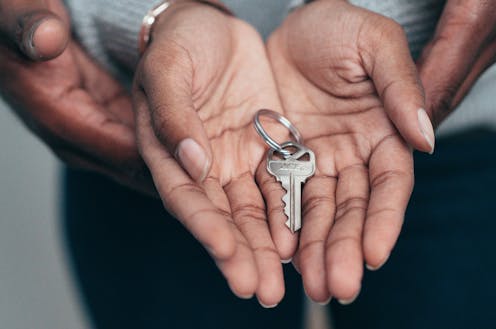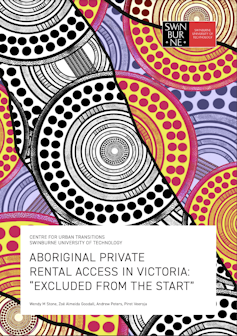Source: The Conversation (Au and NZ) – By Wendy Stone, Professor of Housing & Social Policy, Centre for Urban Transitions, Swinburne University of Technology

Pexels, CC BY
Private rental housing provides homes, often long-term homes, for one in four Australian households. People can experience various forms of discrimination when seeking, living in or leaving a rental property, and for Aboriginal and Torres Strait Islander peoples it’s another one of many barriers they face. Our new research presents their views about what needs to change in Victoria’s private rental sector.

Swinburne University of Technology
Discrimination in the private rental market disproportionately affects households that include Aboriginal and/or Torres Strait Islander people. Of these households, 34.2% (120,245 households) rented privately at the time of the 2021 census. This is related to other housing issues they experience, including lower rates of home ownership.
For the report launched today by the Victorian government, we investigated the systemic barriers Aboriginal Victorians face in the private rental market. We heard about many problems, but also possible solutions.
Read more:
Racism is still an everyday experience for non-white Australians. Where is the plan to stop this?
A colonial context
The private rental sector is a product of, and fixed within, our colonial past. It reflects a capitalist agenda of economic priorities, which treats housing as a financial investment. Thus, it is disconnected from the inherent cultural connections of Aboriginal peoples.
This disconnection emerges from a broad lack of understanding and awareness of Aboriginal culture and its role in society today. For Aboriginal Victorians, we found the need and desire to feel culturally safe in seeking private rental housing is at odds with the nature of the sector.
How was the research done?
The research stemmed from the recommendations of the Victorian Aboriginal Housing and Homelessness Framework, Mana-na woorn-tyeen maar-takoort. It is part of longer-term Victorian government consultation with Aboriginal peoples across the state.
Indigenous research methodologies informed the research – in particular, the use of yarning with Aboriginal participants. Research yarning privileges their story-telling and perspectives. Their experiences and perspectives informed the research.
We analysed findings and stories using the structure of the “Renter’s Journey”. It breaks down the renting process into eight stages: values and goals; need arises; searching; applying; securing; moving in; living; change.
We looked at each stage to identify both barriers and opportunities for change. Using a housing aspirations approach, we explored policy priorities shared by study participants.
Our research used four main methods:
-
reviews of existing evidence and approaches
-
yarning circles with 26 representatives of Aboriginal housing-related organisations across Victoria
-
yarns with 12 professionals who do work related to private rental housing and Aboriginal tenancies
-
yarns with 19 Aboriginal Victorians with lived experience of the sector.
What did the research find?
For Aboriginal Victorians, barriers arise at every stage of the Renter’s Journey, due to prejudice, discrimination and structural disadvantage. A homelessness and community housing services officer told us:
You get the occasional overt comment, but it’s predominantly a hidden, quite insidious perspective that they have against renting to Aboriginal people. So, yeah, it’s difficult.
Barriers are highest at the point of rental access. In some cases, real estate agencies were reported to have asked prospective tenants about their Aboriginal and/or Torres Strait Islander status. These tenants saw this as inherently discriminatory and unnecessary. As another housing professional said:
You shouldn’t be faced with the choice of ‘am I or aren’t I an Aboriginal person’ when I’m making an application for private rent.
The entire process came with anxiety. A tenant told us:
If you actually talk to a lot of Aboriginal and Torres Strait Islander people, they’ll tell you […] it’s an anxiety, it’s this thing of an overwhelming feeling that comes when they know that the only option they have is to go into private rental, because there’s nothing else available. They’re sick of couch-surfing, they’re sick of living in overcrowding, so they become overwhelmed just by the before, thinking about what the process is going to be. Am I going to be facing this? Is this going to be a challenge? Is this going to be a barrier? Am I going to have enough for this? Or am I going to have enough for the bond? […] Is the real estate [agent] and the owner going to accept an application from an Aboriginal person?
Support workers and professionals we spoke with identified discriminatory practices. These intersected with other barriers such as discrimination on the basis of low income, having lived in social housing, being a single parent, or having pets.
Read more:
Why public housing is stigmatised and how we can fix it
Another tenant told us:
I’ve applied for many places […] I was in a private rental for two years and, yeah, I applied for over a hundred rental properties, and all was not approved. Because of my income, because I’m on Centrelink, because I didn’t have previous rental history with a real estate; just those certain barriers, yeah. My income was a major factor as well.
Our report documents how systemic barriers lead to poor or unsafe housing outcomes, ongoing affordability issues and homelessness.
What are the possible solutions?
We asked participants what could be done to reduce barriers. Many suggested increased collaboration between Aboriginal-controlled organisations, government services and real estate agencies. This would help overcome the cultural disconnect between Aboriginal renters and the system.
Increasing rental assistance payments to reduce poverty was seen as essential.
Specific solutions also included:
-
making processes more transparent by, for example, giving tenants access to residential tenancy databases to help counter discrimination in shortlisting applications
-
cultural training for the real estate industry
-
more mentoring and support for prospective and current renters
-
Aboriginal-owned-and-managed private rental agencies, an idea that participants welcomed.
Initiatives such as Aboriginal Private Rental Access Programs (APRAP) and related support are a promising bridge to better housing for Aboriginal Victorians.
Our report provides cause for concern, but also optimism. Government and industry responses to this research can open the way to more connected, positive pathways.
It is highly likely the discriminatory barriers we found in Victoria are Australia-wide. Private rental can only form a significant and positive part of Aboriginal people’s housing futures where doors are open and access to housing is culturally safe and assured.
![]()
Wendy Stone receives funding from the Australian Research Council, the Australian Housing and Urban Research Institute, Housing for the Aged Action Group / The Wicking Trust, Kids Under Cover and has previously received funding from Homes Victoria. This article is based on research funded by the Victorian Consumer Policy Research Centre / Office of the Commissioner for Residential Tenancies, Victorian Government.
Andrew Peters has previously received funding from the Australian Housing and Urban Research Institute, and is a current board member of Oonah Health & Community Services Aboriginal Corporation in Victoria, from where some of the research participants were recruited. This article is based on research funded by the Victorian Consumer Policy Research Centre / Office of the Commissioner for Residential Tenancies, Victorian Government.
Piret Veeroja receives funding from the Australian Research Council, the Australian Housing and Urban Research Institute, Housing for the Aged Action Group, Kids Under Cover and has previously received funding from Homes Victoria. This article is based on research funded by the Victorian Consumer Policy Research Centre / Office of the Commissioner for Residential Tenancies, Victorian Government.
Zoe Goodall receives funding from the Australian Housing and Urban Research Institute, has previously received funding from Homes Victoria, and is in receipt of an Australian Government Research Training Program Scholarship. This article is based on research funded by the Victorian Consumer Policy Research Centre / Office of the Commissioner for Residential Tenancies, Victorian Government.
– ref. Think private renting is hard? First Nations people can be excluded from the start – https://theconversation.com/think-private-renting-is-hard-first-nations-people-can-be-excluded-from-the-start-192392







